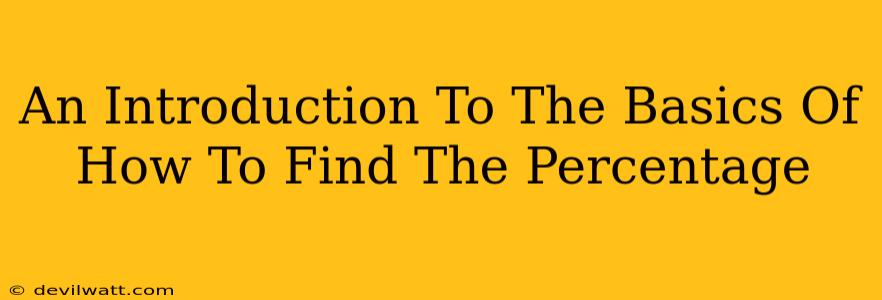Percentages are everywhere! From sale signs in stores to sports statistics and scientific data, understanding percentages is a crucial life skill. This guide will walk you through the fundamental concepts of how to find a percentage, making this seemingly complex topic easy to grasp.
What is a Percentage?
A percentage is simply a fraction out of 100. The word "percent" literally means "out of one hundred" ("per cent" – per hundred). So, 50% means 50 out of 100, or 50/100, which simplifies to 1/2.
Three Key Methods for Calculating Percentages
There are several ways to calculate percentages, and we'll cover three common and easy-to-understand approaches:
Method 1: Using the Formula
The most common method uses a simple formula:
(Part / Whole) x 100 = Percentage
Let's illustrate with an example:
Problem: If you scored 30 out of 50 on a test, what's your percentage score?
Solution:
- Identify the part and the whole: The part is 30 (your score), and the whole is 50 (the total possible score).
- Apply the formula: (30 / 50) x 100 = 60%
Therefore, your percentage score is 60%.
Method 2: Converting to a Decimal
This method involves converting the fraction to a decimal first, then multiplying by 100.
Example: What percentage is 15 out of 25?
- Create a fraction: 15/25
- Convert to a decimal: 15 divided by 25 = 0.6
- Multiply by 100: 0.6 x 100 = 60%
Method 3: Using Proportions
This method is useful when you want to find the percentage of a number. Let's say you want to find 20% of 80.
- Set up a proportion: x / 80 = 20 / 100
- Cross-multiply: 100x = 1600
- Solve for x: x = 1600 / 100 = 16
Therefore, 20% of 80 is 16.
Calculating Percentage Increase or Decrease
Often, we need to calculate the percentage change between two numbers. This is particularly useful when comparing values over time or tracking growth/decline.
Formula for Percentage Increase: [(New Value - Old Value) / Old Value] x 100
Formula for Percentage Decrease: [(Old Value - New Value) / Old Value] x 100
Example: If the price of a product increased from $50 to $60, what is the percentage increase?
- Calculate the difference: $60 - $50 = $10
- Divide by the original value: $10 / $50 = 0.2
- Multiply by 100: 0.2 x 100 = 20%
The price increased by 20%.
Tips and Tricks for Mastering Percentages
- Practice regularly: The more you practice, the more comfortable you'll become with calculating percentages.
- Use a calculator: Calculators can help speed up the process, especially with more complex calculations.
- Understand the context: Always consider the context of the problem to ensure you're applying the correct method.
- Check your work: Always double-check your calculations to avoid errors.
Mastering percentages is about understanding the underlying concepts and applying the right formulas. With practice and these helpful tips, you'll be calculating percentages like a pro in no time!

